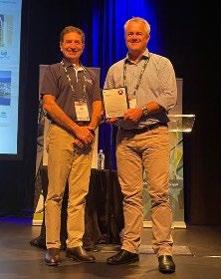STANDARDS
NEW TECHNICAL STANDARD FOR TEMPORARY TRAFFIC MANAGEMENT Temporary traffic management at road worksites is one of the highest risk activities on construction sites. A range of legislation, policy, codes of practice, and guides covering temporary traffic management at road worksites are in place across Australian states and territories. This results in inconsistent practices on worksites, makes it difficult for motorists to understand what they should expect when travelling through road worksites, reduces safety for workers and vulnerable road users and adds to the cost of doing business. New technical document framework for Temporary Traffic Management In December 2019, an updated Australian Standard AS1742.3 Traffic Control for works on roads (2019) and the Austroads Guide to Temporary Traffic Management (AGTTM) were released. Together, these documents detail the standards for temporary traffic management devices and best practice guidance for their use at road worksites. The Department of Transport and Main Roads (TMR) has aligned technical guidance for the Queensland industry to the new national standard and best practice guide. Harmonisation of Queensland’s Manual Uniform of Traffic Control Devices (MUTCD) Part 3 and introduction of the Queensland Guide to Temporary
Traffic Management (QGTTM) aims to increase assurance and protection for workers and improve road user experience through the consistent implementation of nationally recognised best practices in temporary traffic management. The MUTCD Part 3 (2020) will now generally adopt (and not repeat) specifications contained in AS1742.3. The MUTCD will detail the variances to AS1742.3 for use in Queensland. The QGTTM is a new 10-part document that directly aligns with the AGTTM. Each part of the new QGTTM will generally adopt (but not repeat) the guidance contained within the AGTTM. The QGTTM will detail the variances to the practices described in the AGTTM for use in Queensland. Impact of the changes The new technical standards bring changes that need to be adopted into operational practices and organisational safety management systems. Organisations need to develop a plan to ensure staff are aware of the changes and all road worksites are compliant by 1 August 2021. Key dates In Queensland, the AGTTM will be adopted by government and industry in a phased approach: • 1 January to 31 July 2021 – Voluntary adoption • 1 August 2021 – Mandatory adoption.
Preparing your organisation for the changes This will be a significant change for many people in the industry. TMR suggests a few steps that will help your organisation through the transition period. 1. Ensure the relevant people within your organisation are aware of the changes – Perhaps assign a Harmonisation Champion to manage the process internally and ensure they have subscribed to TMR’s Temporary Traffic Management newsletter. 2. Review the relevant documents – AGTTM, MUTCD Part 3, QGTTM, as well as the AS1742.3 (2019). 3. Understand the changes and how they will impact your organisation/projects – Identify supporting business systems and processes that may need to be updated to reflect the changes, such as safety management system procedures, checklists and safe work methods. 4. Implement the changes – Develop a plan to update your operational procedures and communicate the changes to your teams. For further information, please: email tmharmonisation@tmr. qld.gov.au to subscribe to TMR’s Temporary Traffic Management newsletter email TrafficEngineering. Support@tmr.qld.gov.au for advice regarding specific technical changes.
ENGINEERING FOR PUBLIC WORKS | MARCH 2021
77



























